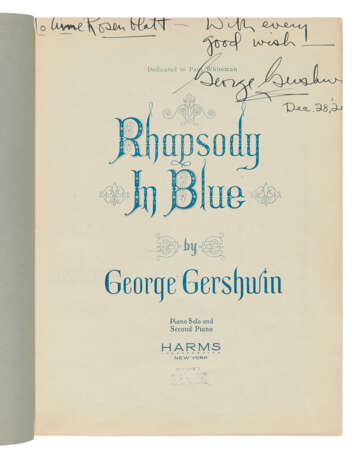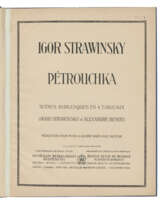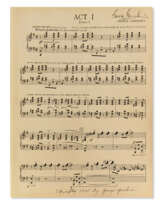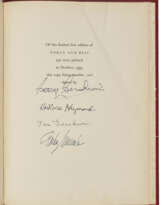ID 1016500
Lot 136 | Rhapsody in Blue and An American in Paris
Estimate value
£ 8 000 – 12 000
George Gershwin
GERSHWIN, George (1898-1937). Rhapsody in Blue and An American in Paris. New York: Harms/New World Music, c.1927 and c.1929.
Early editions of the piano scores, signed and inscribed by George Gershwin to fellow composer Ann Ronell. Rhapsody in Blue inscribed in black ink on the title page ‘To Anne [sic] Rosenblatt – With every good wish – George Gershwin, Dec. 28, ‘2-,’ with three pencil annotations in Gershwin’s hand on the first page of music including ‘marcato’ above the fifth bar and ‘emph’ above the 16th bar, the third undecipherable; An American in Paris similarly inscribed ‘For Anne [sic] Ronell – affectionately, George Gershwin, with congratulations to Omalia. Sept 192-,’ with 34 annotations, rewrites and other markings by Gershwin in pencil throughout the score. The recipient was a student and protégé of Gershwin, who changed her name – apparently at Gershwin’s suggestion – from Ann Rosenblatt to Ann Ronell. Best known for the 1933 Walt Disney hit Who's Afraid of the Big Bad Wolf and the 1932 standard Willow Weep for Me, the latter of which she dedicated to Gershwin, Ronell was the first woman to write both the music and lyrics for a Broadway show with Count Me In in 1942.
Commissioned by bandleader Paul Whiteman to write a piece for a concert advertised as ‘an experiment in modern music’, Gershwin completed his classical-jazz masterpiece Rhapsody in Blue in under a month, performing the piano part himself at the premiere in 1924. 'Attended by the likes of Toscanini, Stravinsky and Rachmaninov,’ writes Matthew Boyden, ‘the concert was a sensation, and it made Gershwin famous overnight.’ Following the premiere of Rhapsody in Blue, Gershwin travelled to Paris with the intention of refining his composition skills under Maurice Ravel. ‘The dapper Frenchman declined,’ states David Schiff, ‘saying, “Why should you be a second-rate Ravel when you can be a first-rate Gershwin?”’. The visit to Paris eventually inspired him to write the orchestral poem An American in Paris, which premiered at Carnegie Hall in December 1928. ‘This new piece, really a rhapsodic ballet, is written very freely and is the most modern music I’ve yet attempted…’ Gershwin explained in Musical America, 'My purpose here is to portray the impressions of an American visitor in Paris as he strolls about the city, listens to the various street noises, and absorbs the French atmosphere.’ Boyden, 150. Pollack, 433. Schiff, 'Misunderstanding Gershwin' in The Atlantic (October 1998).
Two volumes, quarto (292 x 223 mm). Printed musical scores, original self-wrappers respined (title pages trimmed, with slight loss to inscriptions, including the final digits of the date). Housed in a modern custom half-morocco box.
| Address of auction |
CHRISTIE'S 8 King Street, St. James's SW1Y 6QT London United Kingdom | |
|---|---|---|
| Preview |
| |
| Phone | +44 (0)20 7839 9060 | |
| Buyer Premium | see on Website | |
| Conditions of purchase | Conditions of purchase |













